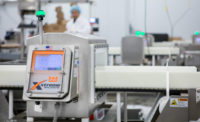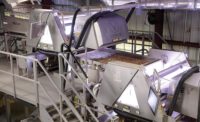The latest metal detection and X-ray inspection equipment can detect small foreign objects, reduce false rejects and handle a wide range of products, which is good news for bakery/snack producers who are striving to improve their quality control programs. The ability to achieve low false reject rates improves overall equipment efficiency, allowing food processors to produce more products in less time.
Manufacturers see two trends affecting inspection equipment for bakery/snack producers: greater product variety and increasing consumer attention to quality and safety. The need to accommodate a growing variety of products requires more versatile inspection systems that can be changed over quickly and easily. The focus on quality and safety demands sophisticated inspection equipment that can find and remove smaller and more difficult-to-detect product defects and foreign material (FM).
Metal detectors that find only metal contamination are being replaced by X-ray inspection systems, which can find a variety of dense objects including metal, according to Marco Azzaretti, advanced inspection systems product manager, Key Technology, Walla Walla, WA. “Digital sorters are being added to production lines because of their ability to find and remove a wide range of defects and FM. Depending on the sensors being used and the intelligence of the software, these sorters can recognize each object’s color, size, shape, structural properties and chemical composition.”
Customers understand that X-ray inspection and metal detection are complementary technologies and that there is a need for both, according to Lanel Menezes, product manager, X-ray, Mettler Toledo Product Inspection, Tampa, FL. “Aluminum in certain applications can be detected well by a metal detector compared to an X-ray system, and stainless steel in certain applications can be detected well by an X-ray system compared to a metal detector. Plastic detection is another challenge that manufacturers face, and our customers are looking for plastic suppliers that can offer metal detectable or X-ray detectable plastics. In addition, the total cost of ownership of product inspection equipment is at the forefront of customer decision-making today, whereas in the past the initial purchase price was the primary driver.”
Incoming ingredients
Manufacturers see more interest in inspecting incoming ingredients such as nuts and dried fruit to ensure that no quality problems are introduced along with these natural, minimally processed products. Menezes notes the following reasons for this trend:
Capturing foreign matter (e.g., large pieces of metal) on the front end prevents potential damage to downstream processing and production equipment
Customers can identify the origin of the foreign matter (e.g., supplier identification) and take corrective action
Risk of a larger contaminant breaking down into smaller, more challenging-to-detect contaminants can be mitigated
Cost savings can be achieved if foreign matter is captured early in the process prior to more value being introduced into the product (e.g., packaging)
Experts also agree that X-ray inspection has evolved to perform multiple functions, such as fill level checks, mass measurement, seal integrity and component counts. However, its growth is not unlimited, according to Bob Ries, lead product manager, metal detection and X-ray inspection, Thermo Fisher Scientific Product Inspection, Minneapolis. “We estimate that less than 10 percent of X-ray machines are actually providing inspection functions in the field because these inspections often are quite challenging due to the natural variation in food products.
“The ingredients can vary, the position of food inside the package can change and common agreement on what is good and bad can be difficult, so creating a mathematical algorithm to reliably reject ‘defects’ can be difficult,” continues Ries. “As a result, the most common, successful applications are gross checks such as presence/absence.”
Smaller contaminants
There is growing interest among bakery/snack producers in detecting smaller metal contaminants and soft contaminations—materials other than metal, such as stone, glass, ceramic and detectable plastics. “As soon as customers start using X-ray, which allows them to see inside their products, a broad range of questions comes up,” Ries explains.
“Typical metal detection sensitivity using X-ray has gone from > 2mm to < 1.2 mm in the last several years,” Ries says. “And in some applications, < 1mm metal detection with X-ray is feasible. Unfortunately, due to the physics of X-ray, and fundamental properties such as density, soft contaminants still pose a challenge. New technologies are required; however, some of the more promising approaches are prohibitively expensive.”
Bakery/snack producers have traditionally processed material on wide belts that do not lend themselves to the narrow X-ray beams used today, Ries adds. “On the other hand, many snacks are individually packaged by flow wrappers; in this case, small, fast X-ray machines are ideal. The difficulty with snacks is the wide array of foods and packages available today. This means that any inspection system purchased by a food processor must be extremely flexible.”
Many bakery/snack environments challenge digital sorters with products that use oils, according to Azzaretti. The equipment must prevent oil ingression to protect sensors and other sensitive components. Key Technology’s VERYX family of digital sorters position sensors, light sources and backgrounds away from contamination zones, thus preventing inspection degradation during the production cycle.
According to Azzaretti, all food processors are challenging equipment suppliers to enhance automation and improve ease of use in an effort to offset the shortage of skilled labor and reduce training requirements. In response, VERYX incorporates smart features such as auto-learning, self-adjustment algorithms, predictive system diagnostics, smart alarms and an intuitive user interface. This enables the sorters to run virtually unattended during normal production.
New inspection systems
Heat and Control Inc., Hayward, CA, has introduced a line of X-ray inspection systems designed to help bakery/snack producers comply with global safety standards and meet the demands of quality and safety-conscious retailers. The Ishida X-ray (IX) series includes a fail-safe system that prevents contaminated products from reaching the consumer in the event of a power outage, helping to minimize the potential for costly recalls. All models offer sensitive foreign body contaminant detection and the ability to identify damaged and missing products or components.
Thermo Fisher Scientific’s new NextGuard C500 X-ray system accommodates wider, taller packages, giving food processors an affordable inspection/detection option for denser, thicker products. The system features an aperture that is 35 percent wider and 50 percent taller than previous models, making it suitable to inspect larger-sized products and cases. It uses a wide X-ray beam and arc-shaped detector designed to eliminate blind spots in the inspection tunnel.
The new Profile Advantage Metal Detector from Mettler-Toledo has simultaneous frequencies that can adapt to fluctuations in product temperature and humidity, which leads to lower false rejects and enhanced detection. Its new X3000 series focuses on enhanced detection capabilities that use multiple inspection algorithms working in conjunction with one another.
Bunting Magnetics, Newton, KS, has introduced the 07 Electronics and Image Phase metal detector. “Image Phase allows the customer to learn each product, store the SKU and change between products during productions runs with ease. Inspection can be performed at the beginning of the process and at the final phase,” says Andrew Blubaugh, product manager, metal detection. In addition, multimode dual frequency allows the operator to process a wide range of items through the detector—for example, from fresh to frozen at the push of a button.
Checkweigher capabilities
The CM3570 CombiChecker system from Mettler-Toledo performs two key inspection functions in one operation. Checkweigher and metal detector setup and configuration are performed at the control panel. Product changeovers result in automatic adaptation of each inspection device to new package parameters. Easily customized from standard modules, the dual-function system can be adapted to suit the requirements of various bakery/snack producers.
The company also has introduced the CV3770 Inspection System, which provides label inspection and checkweighing in one high-speed operation. The system combines Mettler Toledo’s C3000 checkweigher platform with the capabilities of its machine vision technology. The combined technology simultaneously measures product weight and performs multiple inspections of a label’s crucial information—identification number, expiration date and lot number—thus ensuring compliance with weights and measures regulations.
A new checkweigher line for dry applications has been added to the Thermo Fisher Scientific Versa platform. The line is suitable for baked goods, snack foods, prepared foods and baking ingredients. “Our existing Versa checkweighers have been built to accommodate IP65 wash-down for wet product applications. However, the wash-down capability was an unused feature for companies packaging dry products. We developed the Versa Flex models to make precision checkweighing more affordable for companies that previously could not justify the expenditure,” says Rick Cash, product manager, checkweighers, Thermo Fisher Scientific.
Checkweigher models that target dry products are easy to integrate into operations that already run wet products, Cash adds. Because the entire Versa line shares common parts and maintenance procedures, bakery/snack producers can deploy the platform throughout the plant.















